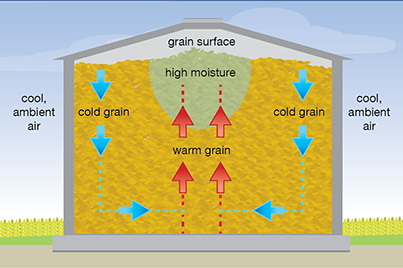It is important to monitor grain temperature and to keep stored grain cool and dry by regular aeration or by turning it. High moisture and warm temperatures in grain allow for the rapid growth of insects, fungi and the possible production of mycotoxins.
Grain stored at lower temperature has less risk of losing quality:
- Lower temperatures allow moist grain to be stored safely for longer periods.
- Even temperature of the grain mass in the silo prevents moisture migration.
- Hot spots are prevented from developing.
- Mould growth is slowed, and insect development is reduced dramatically.
- Cool stored seed retains its viability and vigour for a longer period.
Grain is a very good insulator. When it is undisturbed, it holds temperature well. If warm grain is placed into storage and left undisturbed, convection currents develop and cause hot spots and moisture condensation. The greater the temperature differential (the difference between the temperature of the grain and the outside temperature), the stronger the convection currents. The stronger the convection, the greater the effect of heating and condensation on the grain. This is particularly evident when stored grain is not levelled and the grain bulk forms a peak.

The cycle of convection currents in bin-stored grain when ambient air outside the bin is cold and the grain is warm.
In the bin:
- The surface of the grain bulk forms a peak.
- Grain at the surface and just below the surface has high moisture content.
- Warm grain is located in the centre of the grain bulk.
Arrows in the image represent the convection currents:
- Cold air flows down from the surface of the grain, along the interior of the bin wall. The flow of cold air surrounds the warm grain.
- At the bottom of the grain bulk the cold air is drawn to the centre of the grain by an upward flow of warmer air. The upward flow is a convection current created at the centre of the grain bulk.
- As the cold air is drawn to the centre of the grain, it warms up and flows up to the surface of the grain bulk where there is moist grain.
- The warm air is cooled as it reaches the surface, condenses, and the cycle is repeated.
Respiration and Temperature
During the storage of grain respiration takes place when heat and carbon dioxide are released. The higher the moisture content and temperature, the higher the respiration rate and as a result more and more energy is released. The temperature of the grain can increase so high that heat damage takes place. The only way in which respiration rate can be decreased is to cool the grain by means of aeration.
It is a big dilemma if the build-up of heat is noticed in a bin at a late stage. It can easily happen that the wrong decision is made if an aeration system has not been installed. Corrective steps must then be followed. The following emergency measures can be taken:
- Transfer the grain to an empty silo. This has the advantage of hot and cold grain mixing and can be efficient if heating is detected in the early stages.
- If empty silos are not available and the ambient temperature is low, it can be cooled with the dryer fans.
If silos are equipped with temperature monitor variables, an increase in temperature can be detected sooner and preventative measure can be implemented sooner.
Managing Temperature
Check the temperature of the bin every 2 weeks. Measure temperature by using temperature sensing cables that are permanently installed or by probing the grain with an electronic sensor device.
- Check the grain at least every two weeks until it has been cooled for storage and every two to four weeks during storage.
- Verify that the moisture content is at the recommended storage level.
- Check the grain temperature.
- Inspect for insects.
- Look for indications of storage problems such as condensation on the roof.